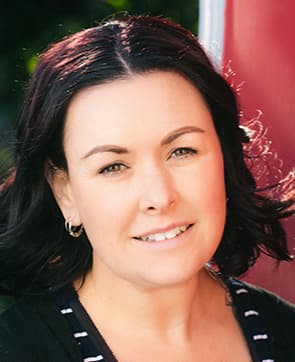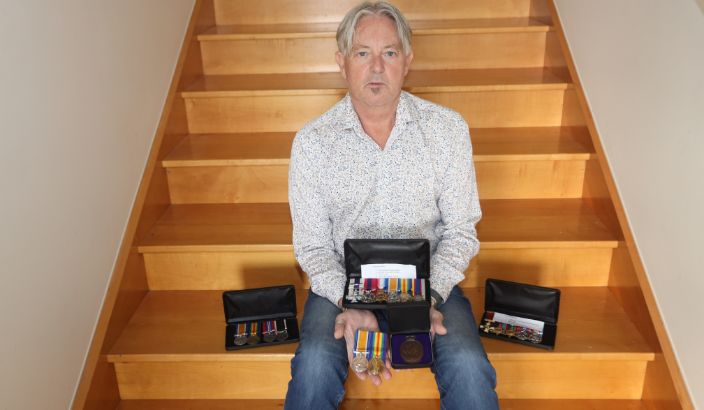Returning to Nelson to honour Watson heroes


Nelson-born Michael Watson has returned home to honour his family on Anzac Day. His great uncle William Watson is thought to be the most highly decorated Australian soldier. Photo: Sara Hollyman
Deputy Mayor of Nelson, Wallabies captain and Winston Churchill’s buddy are just some of the titles that spill from Michael Watson when he discusses a generation of his family that he has returned home to honour this Anzac Day.
William, Walter, Kenneth, Roy and Noel Watson, were all born in Nelson during the late 1800s, and the brothers epitomise the word Anzac, Michael reckons.
This week he is back in Nelson, where his grandfather and great uncles all began their lives, to bring recognition to the service they gave to their country.
William, Walter and Noel together amassed a collection of 17 medals for their service during World War I and II, but it’s William, or Billy, as they refer to him in Australia, who is thought to be the most highly decorated soldier in the country.
William was born in Nelson on 10 November 1887, but relocated to Australia, where his parents originated, at the age of 24 to follow a path of career rugby.
Prior to and after the First World War he had a distinguished rugby union career, representing Australia and captaining the Wallabies on three occasions.
The war cut short William’s rugby career, but would provide ample opportunity for grave displays of valour and courage.
William enlisted early following the outbreak of World War I. In August 1914, he was with the Australian Naval and Military Expeditionary Force that went north to seize wireless stations in German New Guinea. Back in Sydney after this brief action, he was discharged. But in March 1915 he re-enlisted as a Gunner in 1st Divisional Artillery. He landed with reinforcements at Gallipoli in August 1915 and, after action in that theatre, he served on the Western Front from 1916 until the end of the war. He was promoted to Sergeant in 1916.
Back in Australia, he continued with rugby union playing for the New South Wales Waratahs - the top Australian representative side at the time. He led them in three matches against a touring All Blacks side.
Some years later, he left Australia for New Guinea, apparently liking what he had seen there during his brief time.
In 1929 he had married a wealthy American heiress, Cora May Callear and they relocated to Columbiana, Ohio. Whether it was wanderlust or Visa restrictions, back he went to New Guinea to mine gold where he continued to split his time with the US.
With the commencement of war in 1939, William returned to Australia to join up at the age of 52. He was too old for the 2nd AIF but joined the militia and commenced his service with the 2nd Australian Garrison Battalion in Sydney.
In June 1940 his pre-war New Guinea experience was put to use when he was posted to the Papuan Infantry Battalion, a force of native soldiers, Australian officers and non-commissioned officers. He took command of the unit in 1942.
Upon Japan’s invasion of New Guinea on 21 July 1942 and the commencement of the Kokoda Track campaign, the PIB were the first Australian Army unit to make contact with the Japanese. Together with the 39th Battalion the PIB made up Maroubra Force which engaged the Japanese in the first unsuccessful defence of the Kokoda airstrip on 28 July 1942.
Upon the death in action of the battalion commander Lieutenant-Colonel William T. Owen, William took temporary command and led a fighting retreat back towards the village of Deniki. He was promoted to major on 1 September 1942 and in that rank was the commanding officer of the PIB through till April 1944.
It was recorded that the men asked Billy one night why he never seemed to be frightened. William replied that he was as scared as the next man “but you never let the men see it”.
William was a larger-than-life character and a bit of a rebel, according to Michael. But the fact was that he had done things that other men could only dream of, and was a man who had a presence which commanded respect.
Reportedly one evening there was a discussion about the direction the war was headed and the futility of their continuing “mopping up” operations.
“A man’s a fool to keep doing this. I’ve had enough,” William declared. He knew he would never be promoted. So, he told the Army his real age, after previously shaving 10 years off to be allowed back in, was promptly discharged at his substantive rank of Lieutenant, and returned home to his family in the States.
From 1945 to 1952 he served as Australia’s vice-consul in New York. He died in the Veterans Administration Hospital in Brooklyn, New York in 1961.
William Thornton Watson was awarded the Distinguished Service Order, Military Cross with bar, Distinguished Conduct Medal, 1914-15 Star, British War Medal, Victory Medal, 1939/45 Star, Pacific Star and War Medal for his efforts during both wars.
Michael says it’s time the Nelsonians were recognised for their efforts, so this Friday, Michael will stand at Anzac Park, proudly displaying their medals - the first time they are displayed in NZ.
“I’m getting older, and I just thought it’s got to be done sooner or later. I’m the only one in the family that’s really taken a lot of interest in the family tree, so I think it’s about time that I did it.”
While William fought for Australia, the other four brothers fought for New Zealand, and at the end of the day they all came from Nelson, he says. Michael plans to approach Nelson Provincial Museum about eventually taking the medals and honouring the family somehow.
